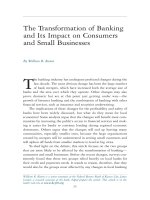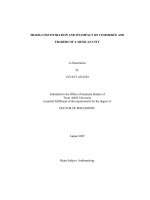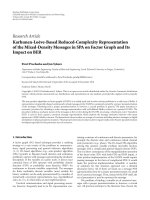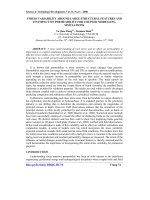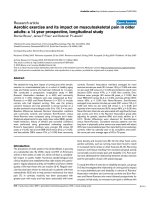fossil fuel consumption co2 and its impact on global climate
Bạn đang xem bản rút gọn của tài liệu. Xem và tải ngay bản đầy đủ của tài liệu tại đây (36.2 KB, 3 trang )
Fossil Fuel Consumption, CO2 and its impact on Global
ClimateBackground:At the beginning of human history, we had to satisfy
our energy needs (for food, heat and movement) by using our own
muscle power and gathering or hunting naturally available plants, animals
and wood. Each stage in the evolution of human society (the
development of farming, domestication of animals, harnessing of wind
and water power) increased the average per capita energy use, but it was
the Industrial Revolution and the exploitation of fossil fuels which marked
the transformation of societies into the energy-intensive economies of
today.Since the eighteenth century the industrialising countries have
come to rely on non-renewable energy resources, and at present about
80 per cent (Myers, 1994) of the world's commercial energy is derived
from oil, coal and gas. Although it has been observed that the growth of
energy consumption is closely correlated with the increases in gross
national product thus our economic development, the major sources of
energy (that is fossil fuels) are 'stock resources'. Fossil fuels are
consumed by use and the current consumption patterns are
non-sustainable. It is recognised that energy conservation and the
development of renewable energy sources will be needed to sustain
economic growth.The quantity of ultimately recoverable fossil fuels is
limited by geology and remains a matter of suspicion, but the view of the
1970s that scarcity was imminent is still popular. It is the 1973 Oil Crisis
marked the transition from abundant, low-cost energy to an era of
increasing prices and scarcity. Today concerns over scarcity have been
overtaken by the question of whether human beings can afford to meet
the environmental costs of continued fossil fuel consumption. One of the
most widespread concern related to global climatic
changes.Introduction:Climate represents normal weather condition of an
area over a period of many years. This is in contrast to weather which is
the day to day changes in the atmosphere. It is now realised that our
global "climatic normals" had fluctuated in the past millions of years which
was nowhere related to human activities. Nevertheless, with the
increasing human population and our reliance on fossil fuels since the
last century, we have definitely 'participated' in the climatic changes which
are taking place to a certain extent.Since the Stockholm Conference in
1972, more and more attentions have been drawn to the issue of global
warming, which is the increase in global temperature caused by the
atmospheric greenhouse effect. We have greenhouse effect because
some trace components of our atmosphere re-absorb and retain certain
wavelengths of heat radiated from the Earth's surface, and the burning of
fossil fuels have increased the tropospheric concentration of all of these
compounds, especially carbon dioxide # (CO2).The Greenhouse Gas 3/4
CO2: A Product of Fossil Fuel Consumption:'Pollution' of the atmosphere
from the consumption of fossil fuels has many effects. Perhaps the best
know are modifications that have led to changes in carbon dioxide.In
some ways carbon dioxide cannot be classified as an air pollutant as it is
reasonably abundant in the natural atmosphere (0.03%), and it is a basic
product of all fossil fuel consumption. Although the chemical reaction in
combustion of fossil fuels is not always simple, it can be summarised as
the release of the carbon combined with atmospheric oxygen atoms to
form carbon dioxide. This process is often referred as respiration, such
that:C6H12O6 + 6O2 + heat (r) 6CO2 + 6H2OHere, we see that carbon
dioxide is not an impurity, as a matter of fact, life on the earth is somehow
depending on this gas, either directly through photosynthesis (plants) or
indirectly via the food-chain (animals). Nevertheless, this gas plays an
important role in the heat balance of the earth, because of its distinctive
heat-storage properties.We often refer carbon dioxide as a 'greenhouse
gas', as the name implies, it is a kind of material that would absorb and
retain heat. Carbon dioxide in the atmosphere is transparent to the sun's
short-wave radiation, which is primarily in the ultra-violent and visible
portions of the electromagnetic spectrum (l=0.1-1 mm). After the incident
radiation has penetrated the atmosphere and been absorbed by the
earth's surface, the earth re-radiates the thermal energy; however,
because the earth's surface temperature is relatively low, the wavelengths
of the terrestrial radiation are now in the infrared (l=4-20 mm). Carbon
dioxide strongly absorbs radiation in the 7 to 14-mm wavelength region,
which overlaps with the peak of intensity of the outgoing radiation. The
net effect of the carbon dioxide in the atmosphere is to prevent some of
the thermal energy from escaping from the earth; hence, it leads to a
heating of the atmosphere. In general, the more carbon dioxide in the
atmosphere, the more heat that will be trapped, and a warmer
atmosphere will result.Change in Atmospheric Chemistry and Global
Warming:The burning of peat, coal, petroleum or natural gas (all
carbonaceous materials) virtually returns the atmospheric carbon that had
been removed hundreds of million years ago by trees and plants in their
process of photosynthesis. Thus in a sudden, relatively brief span of time,
less than two centuries, the contemporary atmosphere has become
burdened with vast additional quantities of a strong infrared absorber,
because of the utilisation of fossil fuels in this period. It is believed that
the level of carbon dioxide has been increasing. Measurements of the
CO2 concentration have been carried out at an observatory on Mauna
Loa, whose data is most quoted and most complete. Observations show
a steady rise in atmospheric carbon dioxide of about 1 ppm per year over
the past quarter of a century. At the South Pole station, the upward CO2
trend closely parallels that at Mauna Loa (Kraushaar, 1988). Forecasts
based on the current rate of fossil fuel consumption suggest that by the
year 2065 the CO2 concentration will increase from its present value of
350 ppm to a value of 600 ppm. It has been estimated that the
pre-industrial level of carbon dioxide have been as low as 260-70 ppm by
volume (Goudie, 1994). Thus, it appears that the industrial world is
increasing the atmospheric CO2 contents by an appreciable amount.It is
arguable that the increase in CO2 concentration may not be induced by
fossil fuel consumption since the carbon cycle is always operating, it
could be due largely to a reduction of the biomass. However, Kraushaar
and Ristinen suggested that the net biotic pool of CO2 has not been
modified sufficiently to account for the carbon dioxide increase. They said
that, "Although there has been cutting of forests, there has also been
intensive agriculture established by irrigation of land that was previously
not very productive." and the combustion of fossil fuels is that major
source of the increase in atmospheric CO2. Moreover, as the amount of
fossil fuels consumed each year is approximately known, the CO2
released can therefore be estimated. Together with the level of CO2
concentration obtained in various stations in the earth, it is calculated that
52% of the 14 billion tones of carbon dioxide is being retained in the
atmosphere per year; and 37% sinks into the oceans, whereas the
depositional locations of the remaining 11% remain mysterious at present
(Kraushaar, 1988).The next question comes with the effect of these
carbon dioxide increases on global climate and here is where the
controversy lies. Vostok ice-core data suggest a close correlation
between CO2 levels and mean surface temperature over the past
160,000 years (Benarde, 1992), but scientist still cannot figure out
whether carbon dioxide leads temperature shifts or temperature changes
leads CO2 shifts. There may even be a third factor provoke both CO2
and temperature changes. Moreover, the upward trend of the
contemporary global warming only lasts for 15 years (Tolba, 1992). There
have been much fluctuation on temperature before 1900. For example, in
Europe, particularly low temperature normals have been experienced
during the period 1430 to 1850 A.D. Therefore, 'global warming' could just
be another natural fluctuation in temperature. At present time, using our
current understanding on the atmosphere that based on hypothesises
and models, we cannot yet make accurate predictions on the future
climate.Conclusion:Although there are still many problems regarding the
relationship of carbon dioxide and global climatic changes and even
global warming itself, there is little question that climate (temperature)
and CO2 are inextricablely linked (from the ice-core studies) and the
temperature of the earth has been increasing over the last decade. More
on that, it is a fact that the burning of fossil fuels do release
infrared-absorbing carbon dioxide to our atmosphere. Therefore, it is just
a logical conclusion that the greenhouse is here, as it always does. It
appears that there is excessive heating within the greenhouse which is
induced by our increasing rate of fossil fuel consumption, and the
problems that lies behind global climatic change are far reaching .
Perhaps, the real limit to our fossil fuel consumption will be the CO2
problem but not the size of the resource. A Chinese proverb says that
"prevention is better than cure." Approaches to energy conservation could
be the key.Bibliography:Benarde, M. A., 1992, Global Warning Global
Warming, John Wiley & Sons, Inc., 52-65.Goudie, A., 1994, The Human
Impact on the Natural Environment, Cambridge: The MIT Press,
301-7.Kraushaar, J. J. & Ristinen, R. A., Energy and Problems of a
Technical Society, John Wiley & Sons, Inc., 394-400.Myers, N., 1994,
The Gaia Atlas of Planet Management, London: Gaia Books Limited,
96-113.Tolba, M. K., 1992, The World Environment 1972-1992, London:
Chapman & Hall, 61-71.

